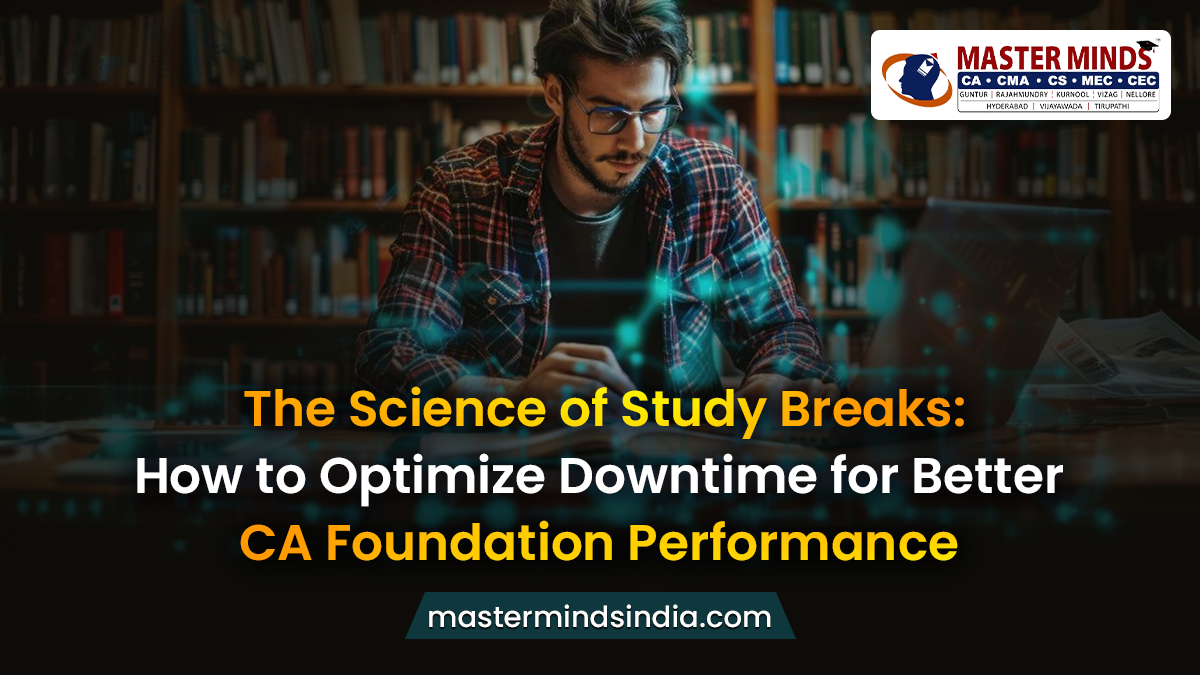Welcome to Mastermindsindia.com. In the high-stakes realm of CA Foundation preparation, where every study session counts, the concept of taking breaks might seem counterintuitive. Yet, emerging research reveals that strategic downtime is not just beneficial but essential for peak performance.
Imagine your brain as a high-performance engine without periodic maintenance and cool-downs, even the best engines overheat and underperform. This comprehensive guide delves into the science of study breaks, uncovering how the strategic use of downtime can supercharge your CA Foundation exam preparation. Prepare to unlock the secrets of optimizing your breaks for maximum efficiency, focus, and exam success.
Understanding the Neurobiological Basis
The effectiveness of study breaks is grounded in neuroscience. Here’s how breaks contribute to improved performance:
- Cognitive Restoration: Continuous study without breaks leads to cognitive fatigue. Research shows that short breaks help restore mental energy, preventing burnout and enhancing focus. This phenomenon is linked to the brain’s need for intermittent rest to maintain optimal function.
- Memory Consolidation: During breaks, the brain processes and consolidates information learned during study sessions. This process, known as “memory consolidation,” strengthens neural connections and improves long-term retention of material.
- Enhanced Creativity: Downtime fosters creativity and problem-solving. The brain often continues to process information subconsciously during breaks, leading to breakthroughs and innovative solutions when you return to studying.
- Stress Reduction: Breaks help reduce stress and anxiety, which can impair cognitive function. Engaging in relaxing activities during breaks lowers cortisol levels, improving overall mental well-being and focus.
Maximizing the Impact of Your Study Breaks
To harness the full potential of your breaks, employ these evidence-based techniques:
- Follow the 50/10 Rule: Study intensely for 50 minutes and then take a 10-minute break. This approach aligns with research on optimal study intervals, ensuring that you maintain high levels of focus and avoid cognitive fatigue.
- Incorporate Physical Activity: Use breaks for physical exercise, even if it’s just a short walk or stretching. Exercise boosts blood flow to the brain, enhancing cognitive function and reducing stress. Activities like yoga or quick workouts can rejuvenate both body and mind.
- Practice Mindfulness and Relaxation: Engage in mindfulness practices, such as deep breathing or meditation, during breaks. These techniques help calm the mind, improve concentration, and enhance overall mental clarity.
- Switch Up Your Environment: Change your surroundings during breaks. Stepping away from your study area to a different setting can refresh your mind and improve focus when you return to your work.
- Stay Hydrated and Nourished: Use breaks to drink water and have a healthy snack. Proper hydration and nutrition support cognitive function and prevent fatigue, ensuring that you stay sharp throughout your study sessions.
Designing a Personalized Break Strategy
Create a study break routine tailored to your needs and preferences with these steps:
- Assess Your Optimal Study Duration: Experiment with different study intervals to determine what works best for you. While the 50/10 rule is effective for many, some may find shorter or longer study periods more suitable.
- Select Break Activities That Energize You: Choose break activities that resonate with you personally. Whether it’s listening to music, engaging in a hobby, or simply relaxing, the right activities will help you recharge and return to studying with renewed energy.
- Incorporate Social Interaction: Brief social interactions during breaks can be refreshing. Engaging in light conversation with friends or family can provide a mental break and enhance your mood.
- Monitor and Adjust: Keep track of your productivity and focus levels in relation to your break schedule. Adjust the timing and nature of breaks based on your observations to optimize performance.
You Can Also Read:
- CA Intermediate New Study Material
- CA Course Duration After 10th, 12th & Graduation
- Tips to Crack CA in First Attempt
- Time-Saving Calculator Tricks for CA Foundation Students
- How to become a CA?
- CA Foundation New Syllabus
- CA Inter New Syllabus
- ICAI CA New Scheme
Inspirational Examples of Breaks Leading to Success
Explore how effective break strategies have helped individuals achieve their goals:
- Success Story 1: The Balanced Approach: A CA Foundation student adopted the 50/10 study-break routine, incorporating physical activity and mindfulness. This approach led to significant improvements in focus, retention, and exam performance.
- Success Story 2: The Creative Break: An aspiring CA used study breaks to engage in creative hobbies like drawing and writing. These breaks not only provided relaxation but also enhanced problem-solving skills and exam readiness.
- Success Story 3: The Social Connector: By integrating brief social interactions into study breaks, a student experienced reduced stress and improved motivation. This strategy fostered a supportive study environment and led to better exam results.
Anticipating Innovations and Emerging Strategies
The concept of study breaks continues to evolve. Here’s what to watch for in the future:
- AI-Powered Break Recommendations: Advances in artificial intelligence may lead to personalized break recommendations based on individual performance data and cognitive patterns. These AI-driven insights could optimize break timing and activities.
- Integration with Study Apps: Future study apps may incorporate break management features, offering real-time suggestions for effective breaks based on your study progress and performance.
- Holistic Wellness Approaches: Emerging trends may emphasize a holistic approach to breaks, integrating physical, mental, and emotional wellness strategies to enhance overall study effectiveness.
CA & CMA Online Classes:

